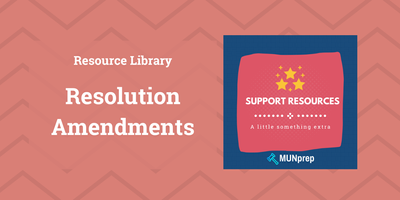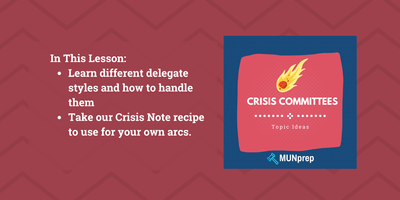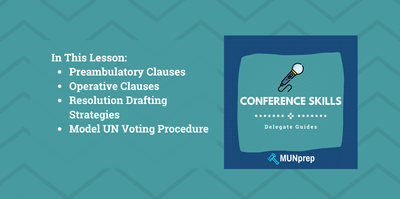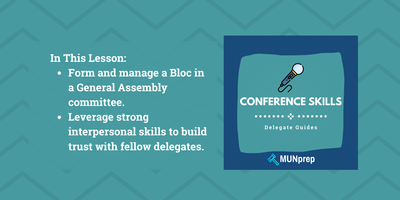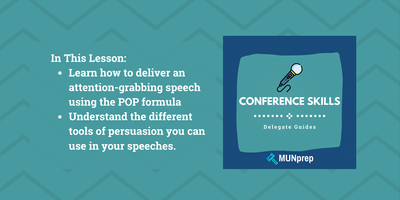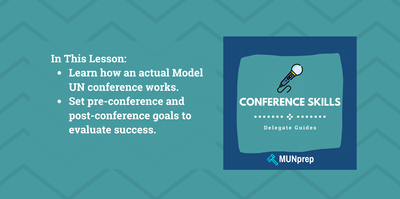MUN Points and Motions – How to use them properly
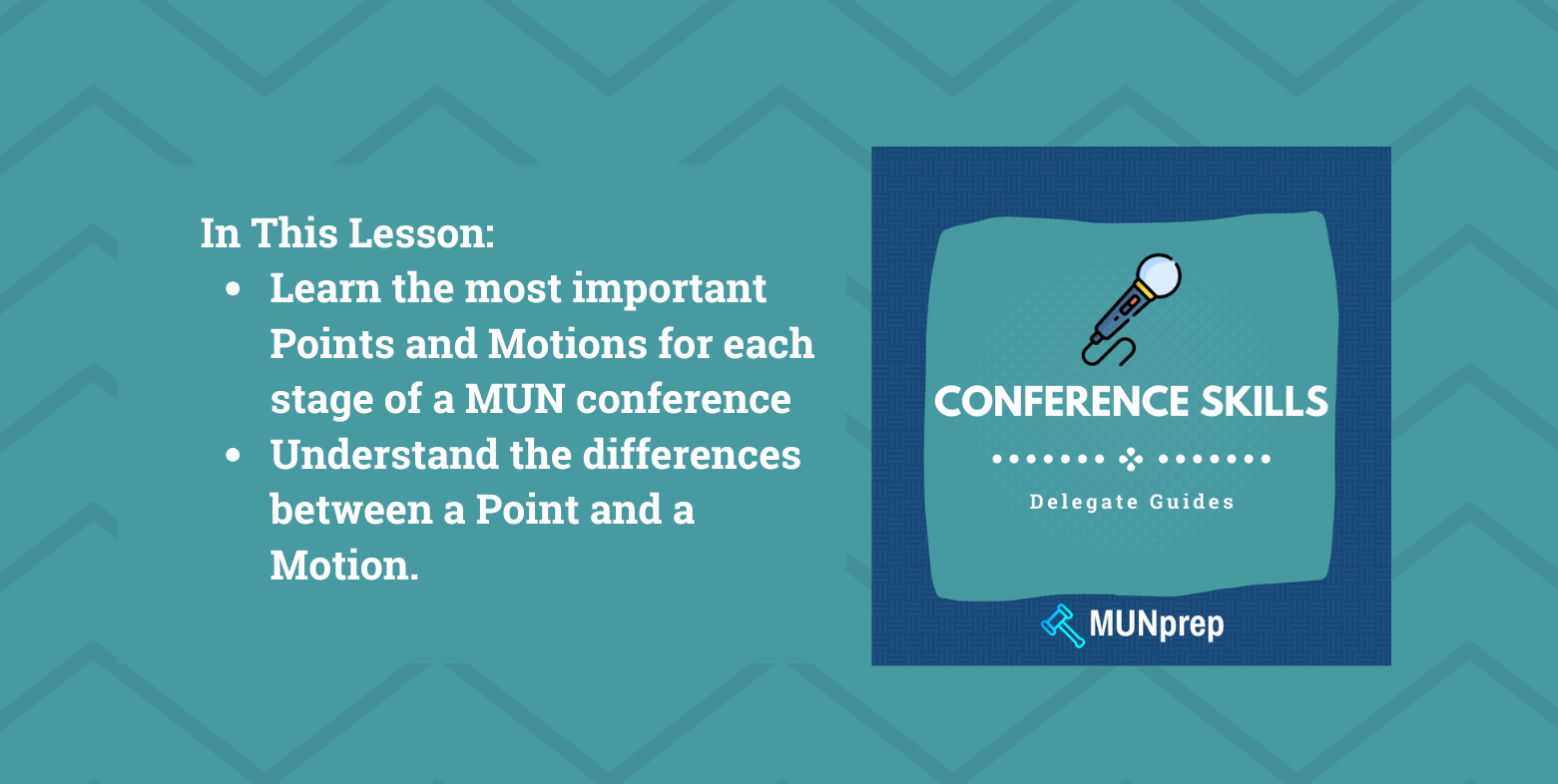
MUN Points and Motions
Points and motions are important. They outline how topics are prioritized, the way resolutions are voted on and they facilitate the general flow of debate. They are a core aspect of MUN and without them, every committee session would be in complete disarray. Today, we’ll teach you some basics of points and motions, what each one does and how to use them properly.
In this guide, we cover points and motions for both regular and crisis committees. If you want to learn more about the difference between these committee styles, check out our guide here.
Placards
The first thing to know is that in a committee all delegates will have a placard. In order to say anything, you should raise your placard and get called on by the Chair (if you’re in an online conference you might not have one but the system will be similar). You should raise your placard both to make a point or a motion and if you want to speak about a particular topic.
Points
Points are used to discuss something outside of substantive debate. They are more personal and don’t require a vote. A Point of Order and Point of Personal Privilege have a special level of priority, this means that a delegate may interrupt the Speaker or Chair in order to express their concern. Delegates should only take advantage of this level of priority when necessary.
Points used in MUN
Point of Order - these are used to correct a procedural error.
E.g. The chair forgot Roll Call.
Point of Inquiry - Used to ask the Dais a question regarding Parliamentary Procedure.
Point of Personal Privilege - Used with to express a personal concern.
E.g. The room is too warm, your placard broke, or you cannot hear the speaker.
Point of Information - Used to ask a delegate a question so they may clarify a speech. (Not always permitted and used only during the speakers list)
How to raise a Point in Committee
1 – Raise your placard and get called, if it is a point of Personal Privilege or a Point of Order, you may interrupt the flow of debate within reason.
2 – State the point that you are going to raise and what you would like to say
E.g. – “Point of Order, we forgot roll call at the start of debate”
Motions
Motions are used to discuss procedural matters and they help to further the discussion on your committee topic. Most motions will require a vote in order to pass. This voting procedure will vary depending on your conference, so you should always consult your background guide or committee handbook to be sure.
There are different stages of a MUN conference and you will need to use a different set of Motions for each step.
The Flow of debate
In MUN, the flow of debate is the term used to break down the stages of a MUN conference. A committee session normally moves progressively along a 4 step process. The diagram below shows how this system works.
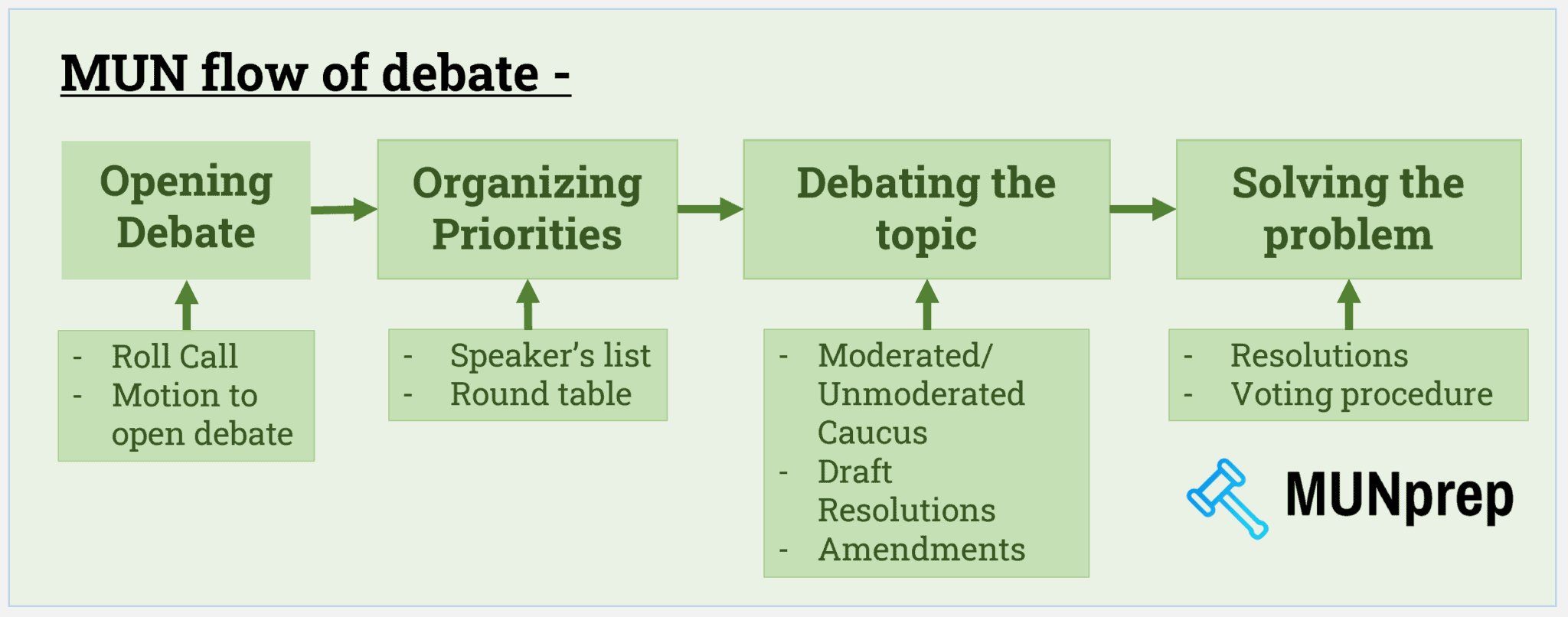
If you want to learn about the speakers list, moderated caucuses and unmoderated caucuses, check out our guide here!
Next, we will show you which Motions to use at each stage and how to use them properly:
1 – Open Debate
Opening debate is simple; all you do is get there on time, be ready for roll call and motion to open debate (E.g – “Motion to open debate”) if the Chair calls on you.
Regular & Crisis Committees
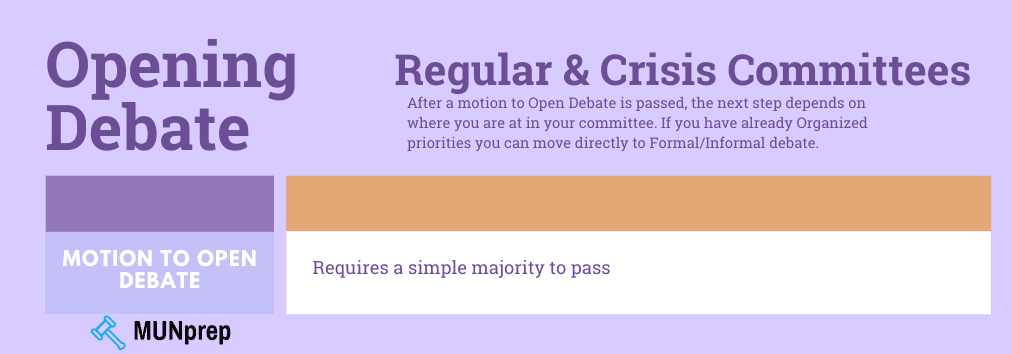
After a motion to Open Debate is passed, the next step depends on where you are at in your committee. If you have already completed the Organizing priorities stage then you can move directly to Formal/Informal debate.
2 – Organizing Priorities
The speakers’ list is the core part of the organizing priorities stage. In Regular committee styles, there are two speakers lists. This happens because there are normally multiple topics on the agenda.
The Primary Speakers list is used to determine which one to discuss first. Once this has been selected it is time to begin discussing solutions, this is when the committee moves to the Secondary speakers’ list and eventually Formal/Informal debate. The delegate who makes the motion to open a Speakers list is automatically added and may choose to speak first or last.
Regular Committees
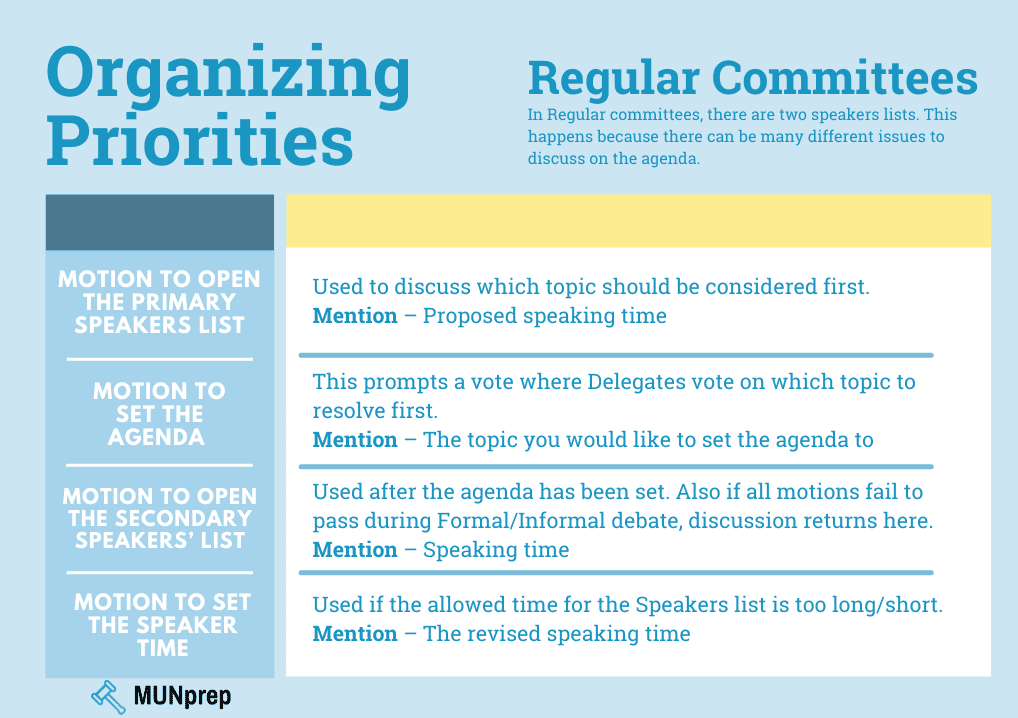
Crisis Committees
In Crisis committees, it is not common to see a Primary and Secondary speakers list. The crisis at hand is the topic to address and it is important to quickly begin discussing solutions. A Round Robin is an efficient way of hearing everyone’s opinion. Here, delegates speak in a clockwise rotation around the table starting with the person who made the motion.
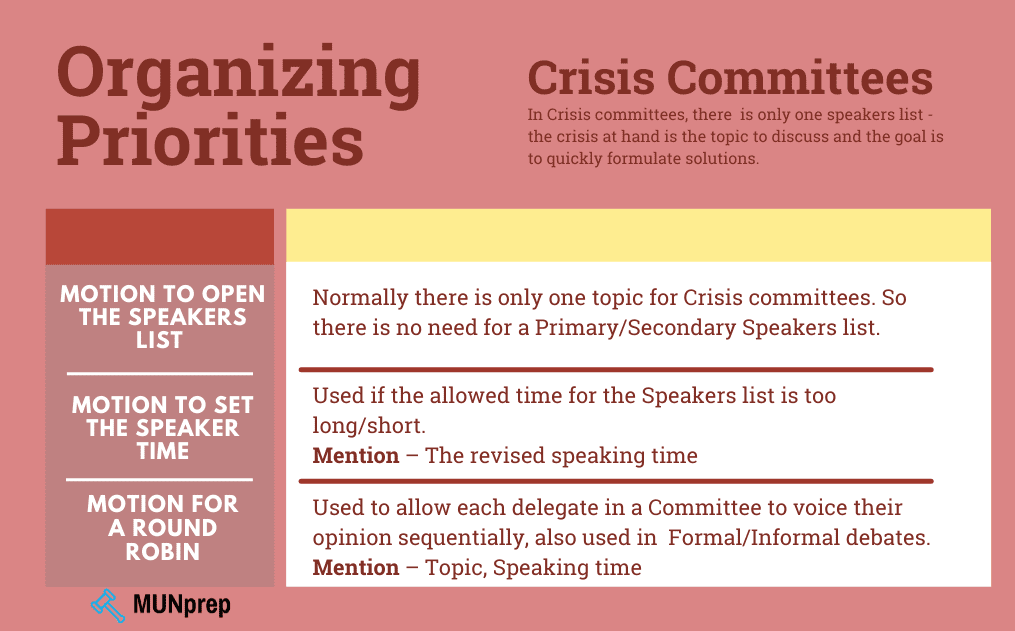
Example Motions
How to motion to open the speakers’ list – “Motion to open the Primary/Secondary Speakers list with a 1 minute speaking time”
How to motion to set the agenda – “Motion to set the Agenda to topic A”
How to motion to set the speaker time – “Motion to set the speaker time to 1 minute”
How to motion for a Round Robin – “Motion for a Round Robin to discuss preliminary solutions with a speaking time of 30 seconds”
3 – Debating the Topic
Delegates will spend most of their time debating solutions for their topic through Formal/Informal Debate. There are many different aspects of this category. This includes Caucuses, Introduction of Resolutions, and Amendments.
Caucuses
A Caucus is an opportunity to discuss policy ideas. A Moderated Caucus is more formal and is run by the Committee Chair, an Unmoderated Caucus is a time where delegates move around the room and have a more informal discussion on the topic, it is also a useful time to start writing resolutions.
A delegate who makes the motion for a Moderated Caucus has the option of speaking first or last if the motion passes. It is also possible to extend a motion by up to half of the original time for both Moderated and Unmoderated Caucuses.
Check out our advanced guide on moderated caucuses here
Introduction of Draft Resolutions
After you have written your Working papers, you must submit them to the Dais and subsequently introduce them. An introduction involves reading the Working paper to the committee, in Regular committees there may also be a Question and Answer period. Once a copy has been introduced and is open for debate the Working paper becomes a Draft resolution.
Curious about MUN Resolutions? Check out our guide here!
Amendments
After listening to each Draft Resolution, it is possible to make adjustments to them before you move into the voting procedure on them. In MUN there are both Friendly and Unfriendly amendments. Friendly amendments mean that all Sponsors for a Draft Resolution accept the change. An Unfriendly amendment is not approved by one or more of the Sponsors, in order to get your amendment to pass, a simple majority must vote for it.
Check out our guide on Amendments in Model UN here!
Regular Committees
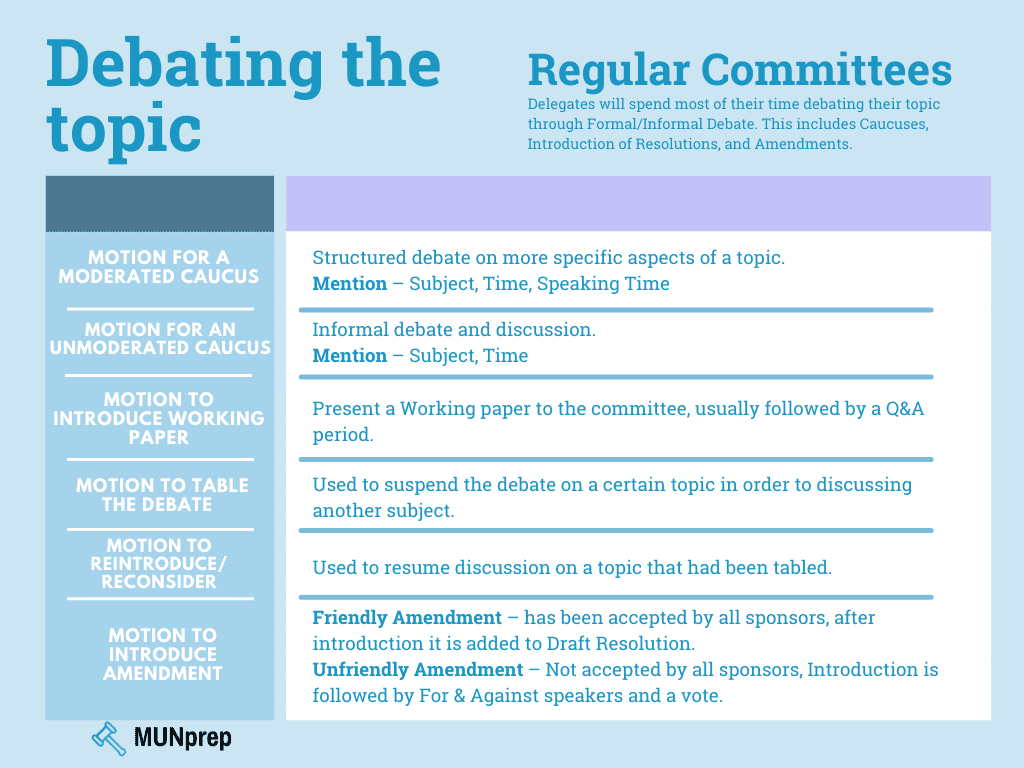
Crisis Committees
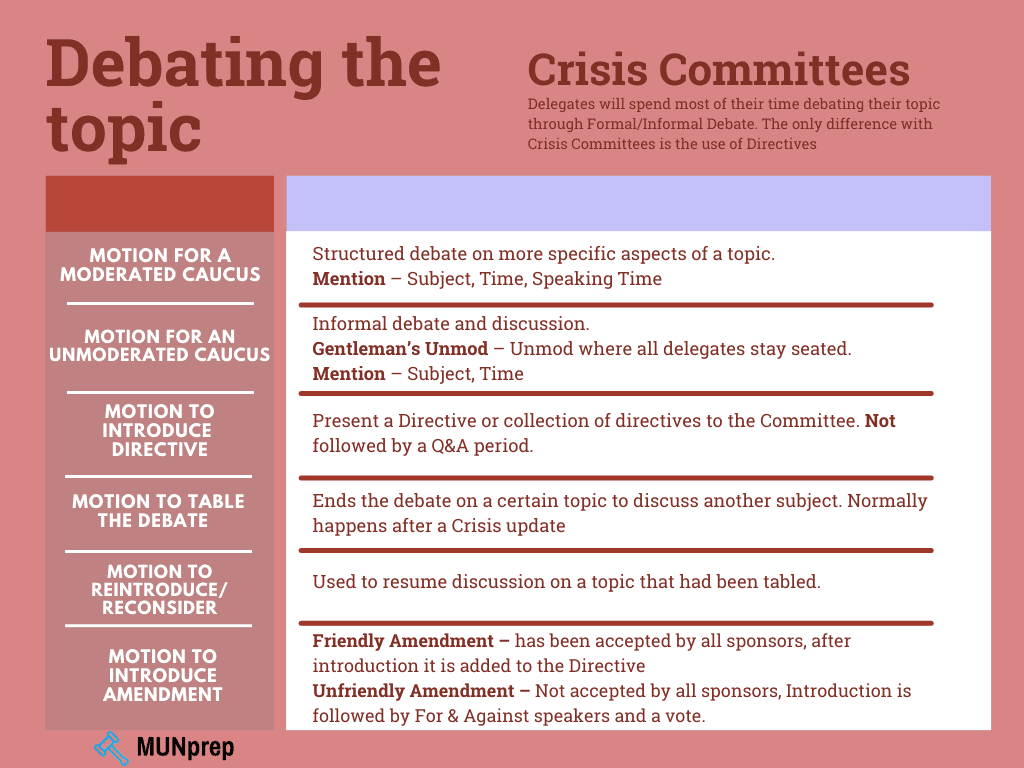
Example Motions
How to Motion for a Moderated Caucus – “Motion for a 9 minute Moderated Caucus with 45 second speaking time on the topic of Renewable Energy sources”
Note – For a Moderated Caucus – make sure that the total Caucus time is divided equally by the number of Speakers. Common Moderated Caucus times: 10 Minutes with 30 Second speaking time, 9 Minutes with 45 Second speaking time, 6 Minutes with 30 Second speaking time.
How to Motion for an Unmoderated Caucus – “Motion for a 15 minute Unmoderated Caucus on the topic of writing Resolutions”
How to Motion for a Gentleman’s Unmod – “Motion for a 12 minute Gentleman’s Unmod on the topic of discussing the recent Crisis update”
How to Introduce a Friendly amendment – “Motion to Introduce the friendly amendment added to Draft Resolution X”
How to Introduce an Unfriendly amendment – “Motion to Introduce the Unfriendly amendment for Draft Resolution Gamma with one for and one against speaker” Note – Sometimes there will be a pre-set number of for and against speakers so you can confirm with your committee chair.
How to Introduce Directives/Working papers – “Motion to introduce all Working papers currently submitted to the Dais/Motion to Introduce Working paper X submitted to the Dais”
4 – Solving the Problem
Once Delegates have finally introduced their Working Papers, it’s time to vote on which Resolutions should pass.
This process involves a formal voting procedure where delegates can make final statements about the benefits of their Resolution.
The Resolutions that pass at this stage will count as the committees official solution for a particular topic!
The Voting procedure in MUN is the same for both Crisis and Regular committees.
Regular & Crisis Committees
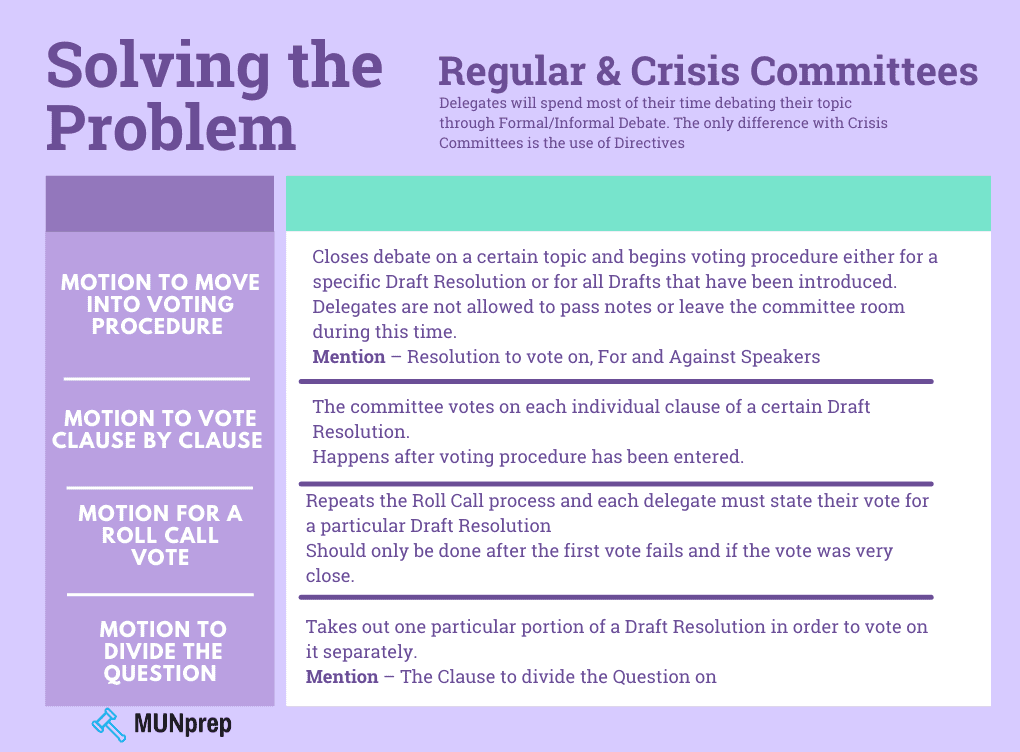
Example Motions
How to Motion to move into Voting procedure – “Motion to move into Voting procedure on all submitted Draft Resolutions with 2 for and 2 against speakers”
How to Motion to vote Clause by Clause – “Motion to vote Clause by Clause on Resolution Alpha”
How to Motion for a Roll Call Vote – “Motion for a Roll Call Vote on Resolution Z”
How to Motion to divide the Question – “Motion to Divide the Question on Clause 4 in Resolution Y”
Bonus!
5 – End of Debate
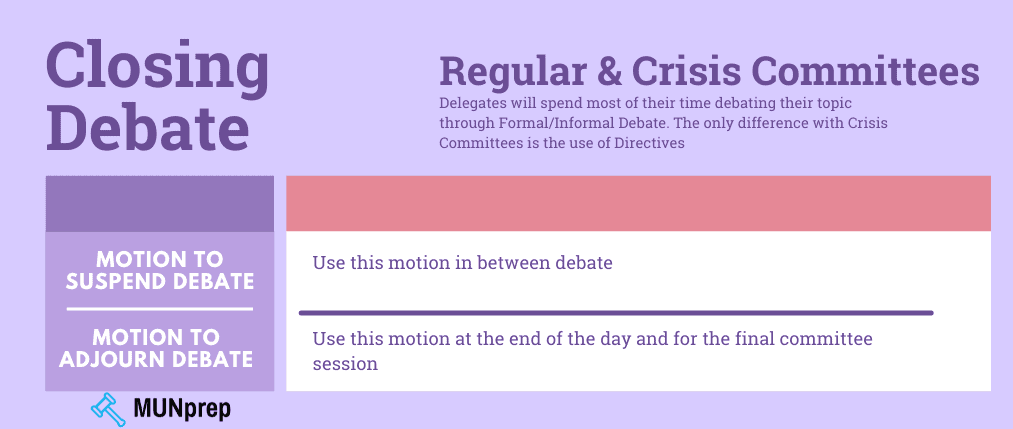
Next Lesson
In our next lesson, we will explore the essentials of Bloc building during an unmoderated caucus!
Knowing how to build a team of the right delegates around you will make every stage of your conference experience much easier.
See you there!



